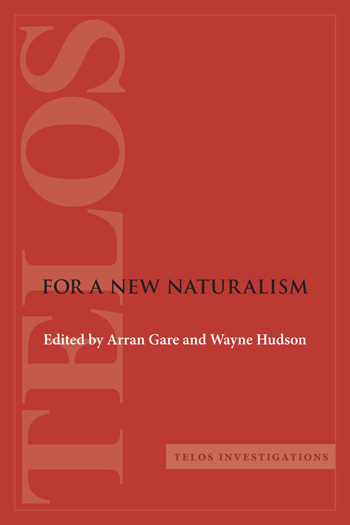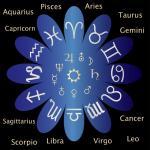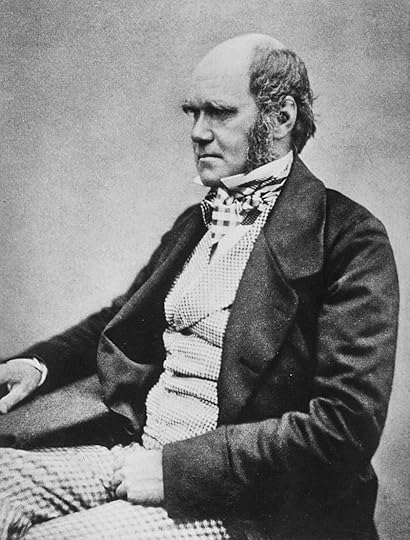Michael J. Behe's Blog, page 423
October 6, 2019
Can process philosophy rescue naturalism?

The old naturalism (nature is all there is), often called “materialism,” is now being jostled by a “new naturalism,” described in a new book, Theses on Critical Theory and Contemporary Naturalism by Wayne Hudson and Arran Gare (eds.). The publisher blurbs it thus:
The culture of modernity has been characterized by at least two competing conceptions of humans, one going back to Hobbes that strives to comprehend humans from a mechanistic perspective, and one inspired by Renaissance humanism, Vico, and Herder that sees humans as creating themselves through their history.
The first view has decisively shaped Anglo-Saxon economics but is now partially undermined by developments in physics and biology going beyond the mechanistic view of nature, notably, non-linear thermodynamics and quantum field theory. Related developments, now revolutionizing biology, provide support for a conception of humans as essentially social beings formed by, and able to reform, their cultures and their contexts. This conception of humans underpins institutionalist economics according to which humans are not self-contained egoists but behave according to the institutions in which they are situated, institutions that have evolved through history and which they are capable of transforming.
The new naturalism will be neither reductionist nor positivist. It will not be a form of scientism but should be informed by the philosophies of freedom developed by Schelling, Fichte, and Hegel and by aspects of the work of C. S. Peirce and A. N. Whitehead. This naturalism will exclude the dualisms of cultural supernaturalism and carry forward the ideals of the European Enlightenment. It will emphasize the need for a thorough critique of historical forms of religion, but it will not be hostile to post-secular perspectives on human spiritual evolution. Indeed, in the longer term it may have to consider the horizon of a global philosophical religion of the kind envisaged by the German philosopher Schelling: a philosophical religion transcending the parochialism and divisiveness of the particular religions and proving forms of ethical orientation for future sentient life.”
Hat tip: Nancy Pearcey, author of Love Thy Body: Answering Hard Questions about Life and Sexuality. She says the authors think we need more “process philosophy” (think Hegel and Schelling) to address the problems.
The old naturalism faces one really big end-stage problem: Naturalizing consciousness means eliminating the idea that it provides accurate representations of facts as opposed to being a mere adaptation for survival. That’s deadly to science.
It’s not clear that woo-woo—that no one really believes based on experience but was rather manufactured for the purpose—can long function as a solution.
View from the UD News coffee room: As process theology empties churches, process philosophy will empty classrooms. Whatever the students do, absent learning, won’t be governed by philosophy. And they won’t care.
See also: Post-modern science: The illusion of consciousness sees through itself
Follow UD News at Twitter!
Copyright © 2019 Uncommon Descent . This Feed is for personal non-commercial use only. If you are not reading this material in your news aggregator, the site you are looking at is guilty of copyright infringement UNLESS EXPLICIT PERMISSION OTHERWISE HAS BEEN GIVEN. Please contact legal@uncommondescent.com so we can take legal action immediately.
Plugin by Taragana
October 5, 2019
Is beauty for its own sake an argument against Darwinism?
Here’s another new vid, for the John 10:10 project, from Illustra Media:
Charles Darwin once wrote that the sight of a male peacock’s tail made him physically ill. Why? Because he knew that the gratuitous beauty so prevalent throughout the living world points unmistakably to intelligent design, foresight and plan. Explore the artistry and stunning implications of natural colors, patterns, and ornamentation in the animal and plant kingdoms that exist for a purpose beyond mere survival.
Note: Darwin went on to develop his theory of sexual selection, to explain such phenomena as the peacock’s tail. While it became dogma that sexual selection explains the peacock’s tail, it’s not clear that the peahen actually cares as much about it as the Darwinist does.
Hat tip: Philip Cunningham
See also: Can sex explain evolution?
Follow UD News at Twitter!
Copyright © 2019 Uncommon Descent . This Feed is for personal non-commercial use only. If you are not reading this material in your news aggregator, the site you are looking at is guilty of copyright infringement UNLESS EXPLICIT PERMISSION OTHERWISE HAS BEEN GIVEN. Please contact legal@uncommondescent.com so we can take legal action immediately.
Plugin by Taragana
How come millennials, educated in Darwin-only science classes, are big on astrology?

We’re not claiming it’s a cause. Just noticing that aggressive defense of Darwinism and other kinds of naturalism proves no deterrent to nonsense:
Many have attributed the current astrology frenzy to millennials’ desire to talk about themselves at every turn. As Amanda Hess wrote at The New York Times last year, “Astrology checks several boxes for viral-happy content: It provides an easy framework for endlessly personalized material, targets women, and accesses ’90s nostalgia. It’s the cosmic BuzzFeed quiz.” …
Whatever kind of care astrology provides, VCs have determined that it is very valuable. In April, Co—Star raised $5.2 million in seed funding to continue growing the app and develop an Android version of it. “By positioning human experience against a backdrop of a vast universe, Co-Star creates a shortcut to real talk in a sea of small talk: a way to talk about who we are and how we relate to each other,” said the company in its funding announcement. “It doesn’t reduce complexity. It doesn’t judge. It understands.”
Allie Jones, “Rising Signs” at The Verge
It’s also flapdoodle. But maybe that doesn’t matter anymore. Why not?
See also: Sceptic asks, why do people who abandon religion embrace superstition? Belief in God is declining and belief in ghosts and witches is rising
Follow UD News at Twitter!
Copyright © 2019 Uncommon Descent . This Feed is for personal non-commercial use only. If you are not reading this material in your news aggregator, the site you are looking at is guilty of copyright infringement UNLESS EXPLICIT PERMISSION OTHERWISE HAS BEEN GIVEN. Please contact legal@uncommondescent.com so we can take legal action immediately.
Plugin by Taragana
Penrose and Craig explain the universe for us at Unbelievable
Sir Roger Penrose & William Lane Craig: The Universe: How did it get here & why are we part of it?
Celebrated mathematical physicist Sir Roger Penrose talks to renowned Christian philosopher William Lane Craig about God and the Universe. They discuss Penrose’s ‘3 realms’ view of reality and his Conformal Cyclical Cosmology. Could the fundamental nature of reality, the Big Bang and the fine tuning of the Universe point towards a creator God?
The Big Conversation is a unique video series from Unbelievable? featuring world-class thinkers across the Christian and atheist community. Exploring science, faith, philosophy and what it means to be human.
Hat tip: Philip Cunningham
See also: Does anyone remember the uproar some years back as various intellectual notables scurried to find reasons for not debating Craig?
A walk down memory lane:
Sean Carroll did debate him (2014) as did Sam Harris (2011).
Richard Dawkins backed out. So did Polly Toynbee. Larry Krauss debated him but professed himself “shocked.” (All 2011.)
Penrose surely offers a more thoughtful debate than Dawkins and Krauss anyway. Too bad we had to wait till 2019 to see it.
Follow UD News at Twitter!
Copyright © 2019 Uncommon Descent . This Feed is for personal non-commercial use only. If you are not reading this material in your news aggregator, the site you are looking at is guilty of copyright infringement UNLESS EXPLICIT PERMISSION OTHERWISE HAS BEEN GIVEN. Please contact legal@uncommondescent.com so we can take legal action immediately.
Plugin by Taragana
Before you turn it all over to AI: Why the Laws of Robotics fail

Jonathan Bartlett, Eric Holloway, and Brendan Dixon explain:
Prolific science and science fiction writer Isaac Asimov (1920–1992) developed the Three Laws of Robotics, in the hope of guarding against potentially dangerous artificial intelligence. They first appeared in his 1942 short story Runaround:
A robot may not injure a human being or, through inaction, allow a human being to come to harm.
A robot must obey orders given it by human beings except where such orders would conflict with the First Law.
A robot must protect its own existence as long as such protection does not conflict with the First or Second Law.
Asimov fans tell us that the laws were implicit in his earlier stories.
A 0th law was added in Robots and Empire (1985): “A robot may not harm humanity, or, by inaction, allow humanity to come to harm.” …
[lots of reasons why this won’t work, right down to:]
Eric Holloway suggested how the robot might think that [the 0th Law] out: In which case, the best way to minimize harm to the population is to wipe out everyone. Of course, there is a lot of short term harm in wiping out everyone, but it is much less in aggregate than the accumulation of harm throughout many thousands of future generations. Or, a bit less extreme, sterilize everyone. That way minimize harm to currently existing humans, and there will be no future humans to be harmed. “The Three Laws of Robotics Have Failed the Robots” at Mind Matters News
Back to other stuff soon.
See also: Other sci-fi from Mind Matters News’s Sci-Fi Saturday:
The Brain: Junkyard, Watch, or Antenna? Eric Holloway: A warped genius reviews the options, as he seeks ultimate power – a tale. After many dead ends, Flim realized that all forms of human power are ultimately controlled by the human mind. Thus, if he could harness the power of the mind, he would finally be able to create anything his heart could desire.
and
Another Life: All fun and games till an AI falls in love Adam Nieri: Then it descends into a convoluted drift of uncertain storytelling. And the victim is not primarily the viewer, who has other options. The victim is the art itself.
Copyright © 2019 Uncommon Descent . This Feed is for personal non-commercial use only. If you are not reading this material in your news aggregator, the site you are looking at is guilty of copyright infringement UNLESS EXPLICIT PERMISSION OTHERWISE HAS BEEN GIVEN. Please contact legal@uncommondescent.com so we can take legal action immediately.
Plugin by Taragana
October 4, 2019
Animal minds: Cats DO bond with people
Both cats and kittens showed about the same level of attachment to caregivers as children and dogs did:
The same pattern was found, not surprisingly, in dogs. We are offered some qualifications with respect to cats …
But the qualifications actually demonstrate the point. Domestic cats bond with humans because they are taken at an early age from the kitty mommy who looked after their every need. As the kitten continues to grow, he expects the humans who adopted him to replace her by feeding and protecting him, and helping him keep warm. Why wouldn’t he? And he certainly does not need reasoning powers to be well aware of the value of that relationship and the need to hang onto it.
Whether he “likes” or “dislikes” his humans is beside the point. Did he “like” Kitty Mommy? Would it even occur to him to form an opinion?
Cats are often charged with being “aloof” and“contrary,” and “not especially social.” But aloofness and contrariness are human concepts and “social” requires some nuance. All these terms assume that the cat is thinking about things that he is not, in fact, thinking about. In reality, he does not have a rich inner life, full of complex, abstract opinions. There is a much simpler but adequate explanation for his behavior.
The cat is neither a pack animal nor a herd animal. Thus he is not inclined by necessity toward submission or leadership.
Denyse O’Leary, “Cats Do blond with peole” at Mind Matters News
 Surely, no one thought I was giving up my position at Uncommon Descent News to be homeless somewhere… – Toby
Surely, no one thought I was giving up my position at Uncommon Descent News to be homeless somewhere… – TobyFollow UD News at Twitter!
See also: Study: Cats do recognize They recognize them as signals but not as abstractions.
and
Can animals reason? My challenge to Jeffrey Shallit (Michael Egnor)
Copyright © 2019 Uncommon Descent . This Feed is for personal non-commercial use only. If you are not reading this material in your news aggregator, the site you are looking at is guilty of copyright infringement UNLESS EXPLICIT PERMISSION OTHERWISE HAS BEEN GIVEN. Please contact legal@uncommondescent.com so we can take legal action immediately.
Plugin by Taragana
Eugenics and the “bad guy” in everyone but Darwin
 Charles Darwin, 1854
Charles Darwin, 1854This article about Francis Galton, Charles Darwin’s cousin, a key figure in the eugenics movement, manages to avoid mentioning Darwin, even though he was clearly among those Victorians for whom racism was a normal point of view:
And by the standards of today, Galton does resemble a monster. He was a brilliant statistician but also a racist (not just my assessment, but that of Veronica van Heyningen, the current president of the Galton Institute). He was obsessed with human difference, and determined to remove from British society those he considered inferior.
Yet as our critical gaze falls on Galton, are we losing sight of just how popular his idea was among so many Britons? In the early 20th century, a surprisingly broad roster of public figures aligned themselves with Galton’s vision. It attracted people on the left and right, prominent writers and intellectuals, leading scientists and politicians. Virginia Woolf, TS Eliot, DH Lawrence, Julian Huxley, Winston Churchill, Marie Stopes – all held eugenic views. Churchill was vice-president of the first International Eugenics Conference, held in London in 1912. Although there were notable critics, to be a eugenicist was to be firmly in the mainstream.
Angela Saini, “In the twisted story of eugenics, the bad guy is all of us” at The Guardian
Okay. How come in a world where nothing is sacred and the bad guy is all of us, Darwin alone is exempt?
See also: Darwin reader: Darwin’s racism
Follow UD News at Twitter!
Copyright © 2019 Uncommon Descent . This Feed is for personal non-commercial use only. If you are not reading this material in your news aggregator, the site you are looking at is guilty of copyright infringement UNLESS EXPLICIT PERMISSION OTHERWISE HAS BEEN GIVEN. Please contact legal@uncommondescent.com so we can take legal action immediately.
Plugin by Taragana
Projectiles found at 20 kya earlier than thought. An advantage for modern humans vs Neanderthals?
From ScienceDaily:
A team of Japanese and Italian researchers, including from Tohoku University, have evidenced mechanically delivered projectile weapons in Europe dating to 45,000-40,000 years — more than 20,000 years than previously thought. This study, entitled “The earliest evidence for mechanically delivered projectile weapons in Europe” published in Nature Ecology & Evolution, indicated that the spearthrower and bow-and-arrow technologies allowed modern humans to hunt more successfully than Neanderthals — giving them a competitive advantage. This discovery offered important insight to understand the reasons for the replacement of Neanderthals by modern humans. Paper.paywall – Katsuhiro Sano, Simona Arrighi, Chiaramaria Stani, Daniele Aureli, Francesco Boschin, Ivana Fiore, Vincenzo Spagnolo, Stefano Ricci, Jacopo Crezzini, Paolo Boscato, Monica Gala, Antonio Tagliacozzo, Giovanni Birarda, Lisa Vaccari, Annamaria Ronchitelli, Adriana Moroni, Stefano Benazzi. The earliest evidence for mechanically delivered projectile weapons in Europe. Nature Ecology & Evolution, 2019; 3 (10): 1409 DOI: 10.1038/s41559-019-0990-3 More.
The thesis that modern humans had a competitive advantage in projectiles might be a bit hasty. One is reminded of the claim that modern humans could do art and Neanderthals couldn’t, and then we found Neanderthal art. Later, we might find Neanderthal projectiles from the same period. Then we could at least compare.
See also: The Neanderthals might have died out from ear infections
and
Neanderthal Man: The long-lost relative turns up again, this time with documents
Copyright © 2019 Uncommon Descent . This Feed is for personal non-commercial use only. If you are not reading this material in your news aggregator, the site you are looking at is guilty of copyright infringement UNLESS EXPLICIT PERMISSION OTHERWISE HAS BEEN GIVEN. Please contact legal@uncommondescent.com so we can take legal action immediately.
Plugin by Taragana
Jonathan Bartlett: Scrutinize evolution claims that depend on curves

Curves often don’t do what people claim:
The exponential curve is one of the most powerful curves in mathematics. Notice how, on the left, the curve begins extremely flat. Then, as it progresses to the right, it gets steeper and steeper moving upward. For the most part, exponential curves occur when effects are compounded, in other words, when causes introduce effects and those effects then join up with the original causes to make a bigger cause.
While you can tell that there is a little bit of upward curve at the end, imagine if you were looking at a scatterplot of noisy data. It would be impossible to distinguish this from a straight line. It is only by knowing the causative structure of the numbers’ meaning that you can distinguish the early stage of an exponential curve from a generic position on a line. This is why bare extrapolation from data can be so dangerous—if you don’t know why the numbers are the way they are, you may be totally misinformed about the nature of the curve you are on.

I have seen this happen with many demonstrations of evolution. Because DNA is a code, as the size of the code gets larger, the size of the search space increases exponentially. Evolution’s ability to occur within a smaller space actually gives almost no meaningful information about its ability to occur in a larger space. On the left-hand side of the curve, the effect really looks linear. But that is a trick of exponential spaces. When we trying to extrapolate the effect out to something bigger, it goes away, because the search space grows exponentially bigger.
Evolution occurs precisely when the genome can use information to restrict the search space for evolutionary targets to a manageably small size, such as when it is modifying genes to produce antibodies for foreign invaders. The cells can’t mutate randomly and achieve success, because the search space is extremely large (about three billion base pairs). Instead, the mutation space is limited to something much more manageable, just half of an existing antibody gene (the half that attached to the invader), where the search space is still large, but manageable— six hundred base pairs. The problem gets exponentially harder as the search space increases so, contrary to conventional wisdom (see also here), what works on a small scale doesn’t work on a larger scale. The exponential space prevents it. Unfortunately, people extrapolate from the front half of the curve as if it were equivalent to the entire curve.
Jonathan Bartlett, “Don’t leave home without these three curves” at Mind Matters News

Yes. An entire Darwinian evolution industry is dedicated to doing that very thing.
See also: Successful generalization is a key to learning In machine learning, the Solomonoff induction helps us decide how successful a generalization is
and
Machine learning tip: Set boundaries for the problems. We cannot take a giant pile of unorganized data, shove it into a machine, and expect useful results
Follow UD News at Twitter!
Copyright © 2019 Uncommon Descent . This Feed is for personal non-commercial use only. If you are not reading this material in your news aggregator, the site you are looking at is guilty of copyright infringement UNLESS EXPLICIT PERMISSION OTHERWISE HAS BEEN GIVEN. Please contact legal@uncommondescent.com so we can take legal action immediately.
Plugin by Taragana
October 3, 2019
Language is much more complex than once thought
The brain regions that enable it are much more complex too. From ScienceDaily:
In recent years neuroanatomists discovered that Broca’s and Wernicke’s regions actually contain multiple neuroanatomical areas. Also, newly discovered language areas extend beyond the classical areas, even into the parietal lobe, with more connections between these areas than previously thought. Moreover, the traditional areas are involved in language comprehension as well as production. Scientist also learned that other regions of the brain are more important for language than once thought, including the right hemisphere and the cerebellum. Interestingly, language areas also turn out to be somewhat variable. For instance, in people who are born blind, language can spread to the occipital lobe (or visual brain).
Our brains process language with astonishing speed and ‘immediacy’, in a dynamic network of interacting brain areas. All the relevant information becomes available immediately, as we start combining the meanings of individual words, unifying the different sources of information. To speed up this process, our brain actively predicts what is coming next (for instance, we might expect ‘newspaper’ to follow ‘the editor of the …’).
As most utterances are part of a conversation, some information is usually already shared between the speaker and the listener. Speakers make sure that they mark ‘new information’, using the order of the words or pitch to focus the listener’s attention (after hearing that readers of the newspaper did not like the article, one could say ‘the EDITOR of the newspaper loved the article’). Only when relevant ‘new’ information is unexpected or ungrammatical, people’s brains are shown to react. Listeners likely process ‘old’ information in a ‘good-enough’ manner, ignoring some of the details, explains Hagoort, which is why they do not seem to notice unexpected ‘old’ information.
To make matters even more complex, language is often indirect. To know what a speaker really means, listeners need to infer a speaker’s intention. For instance, ‘It is hot here’ could well be intended as a request to open the window, rather than a statement about the temperature. Neuroimaging studies show that such ‘pragmatic’ inferences depend on brain areas that are involved in ‘Theory of Mind’, or thinking about other people’s beliefs, emotions and desires.
Language is a “complex biocultural hybrid,” concludes Hagoort.Paper. (paywall) – Peter Hagoort. The neurobiology of language beyond single-word processing. Science, 2019 DOI: 10.1126/science.aax0289
More.
That’s only the beginning. Glad someone understands.
See also: The real reason why only human beings speak Language is a tool for abstract thinking—a necessary tool for abstraction—and humans are the only animals who think abstractly (Michael Egnor)
and
Can we talk? Language as the business end of consciousness
Follow UD News at Twitter!
Copyright © 2019 Uncommon Descent . This Feed is for personal non-commercial use only. If you are not reading this material in your news aggregator, the site you are looking at is guilty of copyright infringement UNLESS EXPLICIT PERMISSION OTHERWISE HAS BEEN GIVEN. Please contact legal@uncommondescent.com so we can take legal action immediately.
Plugin by Taragana
Michael J. Behe's Blog
- Michael J. Behe's profile
- 219 followers



